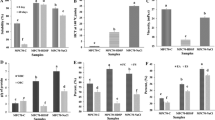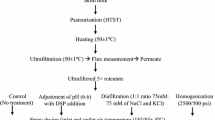Abstract
Milk protein concentrates (MPCs) must be completely dispersed and dissolved in water to fully present their functional properties. However, MPC powders exhibit low solubility and dispersibility and require long rehydration times. In addition, the powders have limited shelf life as their solubility decreases during storage. It is proposed that improvements in the instant powder drying process will improve the rehydration behaviour of MPC powders. In this paper, the physical and rehydration properties of extrusion-porosified MPC powders were examined and compared with those of conventional spray-dried MPCs. This work clearly confirmed that spray-dried MPC powders showed a low dispersibility index (38%), and after 5 h of rehydration, no sub-micron casein micelles were observed in the dispersed phase. In contrast, extrusion-porosified MPC powders exhibited a very high dispersibility index (96%), and the dispersed phase contained only sub-micron particles after 2 h of rehydration. The results suggest that the improved dispersibility is attributed to the dissociation of casein micelles caused by the extrusion porosification treatment prior to drying. Changes in the microstructure of extrusion-porosified MPC powder particles are proposed to support the significant improvement of the rehydration behaviour.




Similar content being viewed by others
References
Anema SG, Pinder DN, Hunter RJ, Hemar Y (2006) Effects of storage temperature on the solubility of milk protein concentrate (MPC85). Food Hydrocoll 20:386–393
Baldwin AJ, Truong GNT (2007) Development of insolubility in dehydration of dairy milk powders. Food Bioprod Process 85:202–208
Bhaskar GV, Singh H, & Blazey ND (2001) Milk protein products and processes, Patent WO01/41578.
Carr RL Jr (1965) Evaluating flow properties of solids. Chem Eng 72:163–168
Durand D, Bouvier J-M, Maller G, Scott M, Stevenson SR, Roberts SJ, Brisset A (2008) Procédé et installation de production en continu d’un produit poreux en poudre, Patent FR 2 907 029.
Gaiani C, Schuck P, Scher J, Desobry S, Banon S (2007) Dairy powder rehydration: influence of protein state, incorporation mode, and agglomeration. J Dairy Sci 90:570–581
Haugaard Sorensen I, Krag J, Pisecky J & Westergaard V (1978) Analytical methods for dry milk products, A/S Niro Atomizer (Editor), Copenhagen, Denmark, pp. 18–21
Havea P (2006) Protein interactions in milk protein concentrate powders. Int Dairy J 16:415–422
Mimouni A, Deeth HC, Whittaker AK, Gidley MJ, Bhandari BR (2009) Rehydration process of milk protein concentrate powder monitored by static light scattering. Food Hydrocoll 23:1958–1965
Mimouni A, Deeth HC, Whittaker AK, Gidley MJ, Bhandari BR (2010a) Rehydration of high-protein-containing dairy powder: slow- and fast-dissolving components and storage effects. Dairy Sci Technol 90:335–344
Mimouni A, Deeth HC, Whittaker AK, Gidley MJ, Bhandari BR (2010b) Investigation of the microstructure of milk protein concentrate powders during rehydration: alterations during storage. J Dairy Sci 93:463–472
Pisecky J (1997) Handbook of milk powder manufacture. Niro A/S, Copenhagen, Denmark, p 159
Schokker EP, Church JS, Mata JP, Gilbert EP, Puvanenthiran A, Udabage P (2011) Reconstitution properties of micellar casein powder: effects of composition and storage. Int Dairy J 21:877–886
Schuck P, Piot M, Méjean S, Fauquant J, Brulé G, Maubois JL (1994) Dehydration of an ultra-clean milk and micellar casein enriched milks. Lait 74:47–63
Schuck P, Davenel A, Mariette F, Briard V, Méjean S, Piot M (2002) Rehydration of casein powders: effects of added mineral salts and salt addition methods on water transfer. Int Dairy J 12:51–57
Schuck P, Méjean S, Dolivet A, Gaiani C, Banon S, Scher J, Jeantet R (2007) Water transfer during rehydration of micellar casein powders. Lait 87:425–432
Schuck P, Dolivet A, Jeantet R (2012) Analytical methods for food and dairy powders. Wiley-Blackwell, Oxford, pp 145–154
Tamime AY, Robinson RK, Michel M (2007) Microstructure of concentrated and dried milk products. In: Tamime AY (ed) Structure of dairy products. Blackwell Publishing Ltd., Oxford, UK, pp 104–133
Udabage P, Puvanenthiran A, Yoo JA, Versteeg C, Augustin MA (2012) Modified water solubility of milk protein concentrate powders through the application of static high pressure treatment. J Dairy Res 79:76–83
Author information
Authors and Affiliations
Corresponding author
About this article
Cite this article
Bouvier, JM., Collado, M., Gardiner, D. et al. Physical and rehydration properties of milk protein concentrates: comparison of spray-dried and extrusion-porosified powders. Dairy Sci. & Technol. 93, 387–399 (2013). https://doi.org/10.1007/s13594-012-0100-7
Received:
Revised:
Accepted:
Published:
Issue Date:
DOI: https://doi.org/10.1007/s13594-012-0100-7




